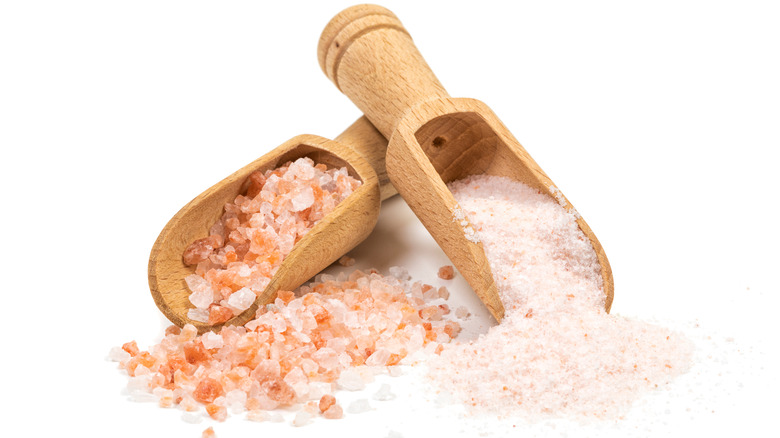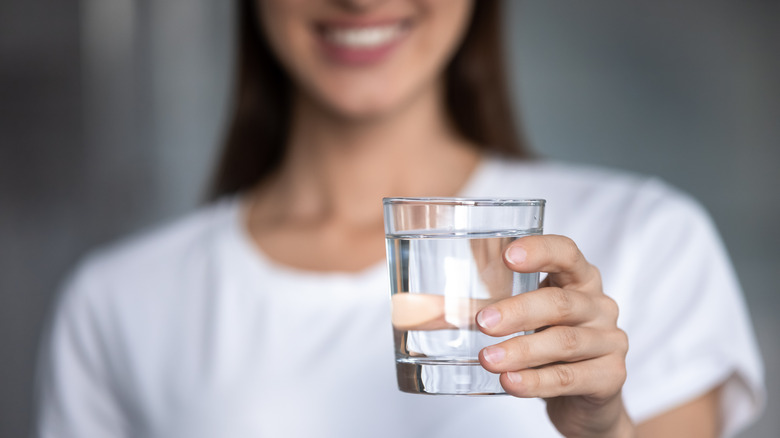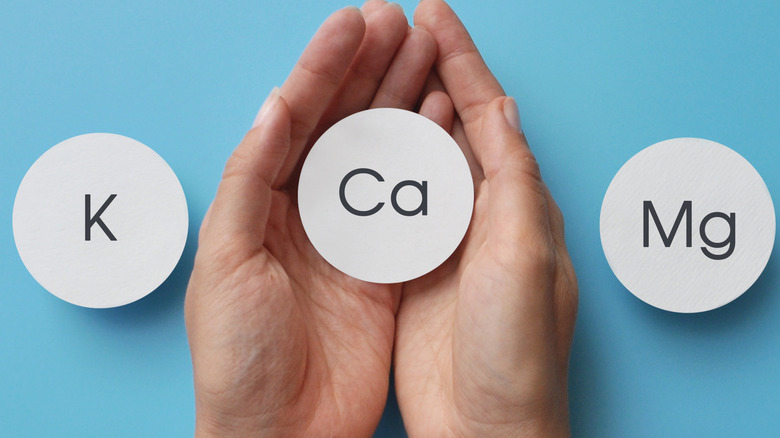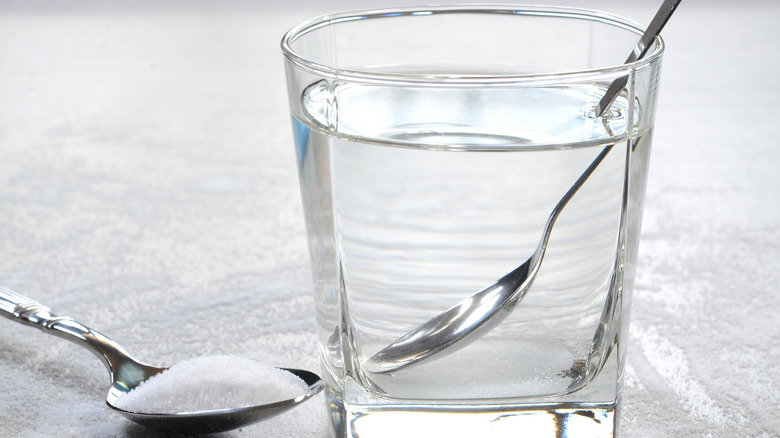The Unexpected Benefit Of Adding Salt To Your Drinking Water
Under the pseudonym, Isak Dinesen, Danish author Karen Blixen famously wrote, "The cure for anything is salt water." If you've ever gone to the beach with a minor flesh wound, took a dip in the ocean, and then noticed the next day that your scrape was nearly healed, you might have had the same thought. However, we would venture a guess that you never considered filling a glass up with ocean water and sipping on it for its healing properties. As the National Ocean Service suggests, doing so can result in negative side effects. However, some believe that adding a little bit of salt to your drinking water might offer some surprising health benefits.
Sole (pronounced so-lay) water is created by saturating regular drinking water with pink Himalayan salt (per Healthline). While it's important to note that no scientific research has supported the claims of sole water proponents, the people who swear by it believe it can aid in hydration, improve sleep quality, and supply the body with essential minerals. Let's explore the supposed health benefits of sole water and discuss if, and how, you should consume sole water for the betterment of your health.
Sole water for improved hydration and sleep quality
Sodium is an essential mineral that maintains fluid balance throughout the body, and if we don't get enough of it, it can lead to problems like dehydration (per Healthline). For this reason, sole water advocates suggest that it can keep you better hydrated. Healthline notes, however, that drinking saltwater is no more effective in helping you meet your sodium requirements than consuming naturally salty foods. In fact, Himalayan salt contains less sodium than regular table salt.
Sole water enthusiasts also believe that sipping on salty water is good for your sleep quality. A 1983 study published in the Journal of Endocrinology and Metabolism looked at 10 young men who consumed less than 500 milligrams of salt a day and found that they experienced sleep disturbances. However, a 2015 article published in the Journal of the American College of Cardiology reports that the average daily salt intake in the United States is 3,200 milligrams, making 500 milligrams relatively low. Furthermore, a 2014 study published in the Journal of Sleep Research concluded that more salt was actually associated with greater difficulty in maintaining sleep.
Sole water for mineral content
One of the biggest reasons sole supporters love the stuff is because they believe it boasts impressive mineral content. Unlike other salts that are often highly processed, pink Himalayan salt is relatively untouched. It is chock full of 84 minerals and other elements, including potassium, calcium, and magnesium (per Healthline). While the minerals are certainly present, they are at such low levels that they're inconsequential when compared to whole foods offering the same minerals. In order for sole water to be a good source of nutrients, you would have to drink so much of it that excess sodium levels would then become a concern.
It's worth noting that in a 2004 paper published by the World Health Organization as a Rolling Revision of the WHO Guidelines for Drinking Water Quality, it was reported that water is not eliminated from the body in its "pure" form, but rather together with salts. Therefore, if distilled or low-mineral water is ingested, the intestine adds electrolytes to it, which come from the body's reserves. Additionally, the paper asserted that evidence from medical experiments and clinical observations indicates that low-mineral water is responsible for the increased elimination of minerals from the body. That being said, Livestrong proposed that adding salt to distilled water is one way to counteract electrolyte imbalances.
How to create and consume sole water
The good news is that if you're still interested in trying sole water to see if it works for you, Healthline maintains that healthy people drinking small amounts of saltwater shouldn't experience any negative side effects. All the same, it's important to ensure you're not consuming too much salt, as MedicalNewsToday mentions that high sodium levels have been linked to kidney stones, high blood pressure, and cardiovascular disease.
To make your own sole water, Healthline recommends grabbing a glass jar and filling a quarter of it with pink Himalayan salt before topping the jar off with water. Cover the jar, shake it up, and let it sit on the counter for 12-24 hours. If there is no salt left at the bottom of the jar, repeat the process until the salt no longer dissolves. This will indicate the water is fully saturated with salt. Most people who champion sole water advise that adding a teaspoon of the solution to an eight-ounce glass of water every day is the best way to see the rewards.
As always, it's best to speak with your doctor first so you can be sure that sole water is a good fit for you and your dietary needs.




